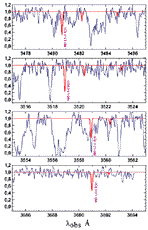The relative abundance of deuterium [D]/[H] formed during Big Bang nucleosynthesis is one of the key parameters of contemporary cosmology because it is the most sensitive indicator of the baryon density in the Universe.
Deuterium abundance at early cosmological epoch (10-14 Gyrs ago) may be determined from high-redshift quasar spectra. Until now, only atomic lines of DI and HI have been used for measuring relative abundances of DI and HI. However, this method meets serious difficulties. DI and HI wavelengths almost coincide, viz l(HI)/λ(DI) = 1.00027. Moreover the column densities of DI and HI differ by a factor of 10-4 - 10-5.
Therefore, DI lines are very weak and practically undetectable when the column density of hydrogen is low. In case the hydrogen column density is high enough, HI lines are saturated and broadened, so that DI lines are lost in the HI lines. In addition, one cannot be sure that the lines treated as DI lines are actually DI and not produced by an intervening weak HI cloud shifted in velocity by -80 km/s. (The latter explanation is possible because the lines in question are situated within Ly-α forest where absorption features are numerous). The above difficulties may be the reasons why [D]/[H] values determined from the atomic lines by different authors differ by more than one order of magnitude. For example, 2·10-4 (Webb et. al, Nature, v. 388, p. 250, 1997), and 1.6·10-5 (Pettini & Bowen, 2001).
The above difficulties do not arise if one measures the relative abundances of molecules [HD]/[H2] since the appropriate wavelengths differ considerably while the redshift parameter is the same. It may be difficult however to derive [D]/[H] from [HD]/[H2] because of uncertainties in the chemistry. Nevertheless this is an independent access to the deuterium abundance in these remote clouds.

Up to now HD lines have not been identified in quasar spectra. Moreover, for a long period, from 1985 to 1997, the only molecular absorption system was known, viz H2 system at zabs = 2.811 imprinted in the spectrum of PKS0528-250 (Levshakov & Varshalovich, MNRAS, v. 212, p. 517, 1985).
In our paper (Varshalovich et. al, Astronomy Letters, v. 27, p. 683, 2001) we report on identification of HD lines of absorption system at zabs = 2.3377 in the spectrum of PKS 1232+082 (zem = 2.57 and mV = 18.4).
The high resolution spectrum of PKS 1232+082 was observed using UVES with the 8.2-m KUEYEN Telescope VLT of ESO by Petitjean et al., 2000. The spectrum contains a strong absorption system of molecular hydrogen H2 at zabs=2.3377 found earlier by Ge & Bechtold (Astron. Soc. Pac. Conf. Ser., v. 156, p. 121, 1999).
Figure shows fragments of the observed spectrum of PKS 1232+082, and our synthetical fit of HD lines (red curve). One can see R(0) lines in L 5-0, L 4-0, L 3-0, and L 0-0 bands and some possible R(1) lines whereas HD lines in L 2-0 and L 1-0 bands are heavily blended by H2 lines.
In conclusion, we emphasize that the detection of HD molecules in absorbing matter at such high redshift may be important to understand the formation of the first generation of stars because HD molecules might be important cooling agents in the primordial condensations where heavy elements were in deficit.